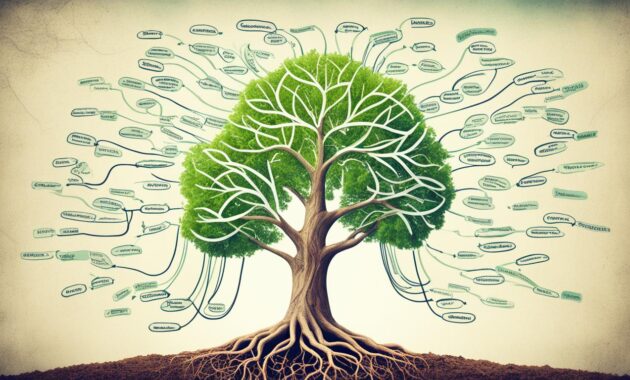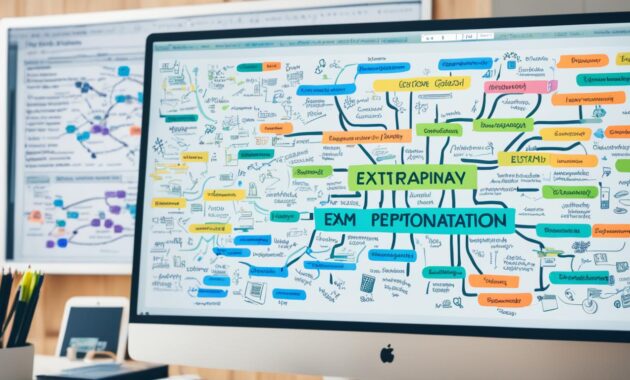Mind Maps Can Improve Exam Results When it comes to exam preparation, every student is looking for an edge to boost their performance. One powerful tool that can make a real difference in your study sessions is the use of mind maps. By harnessing the mind mapping technique, you can unlock new levels of understanding and retention, ultimately leading to improved exam results.
Mind maps are a visual representation of information that helps you organize and connect ideas in a non-linear way. They use a concept map structure, with a central topic and branches radiating out to subtopics. This creative approach stimulates students’ creativity and enhances their learning experience.
Studies have shown a clear relationship between students’ academic performance and their study habits. Incorporating mind maps into your study routine can help you develop effective and efficient learning strategies. With mind maps, you can visualize complex concepts, make connections between ideas, and engage in active learning.
In the following sections, we will explore the benefits of mind maps for students, the science behind their effectiveness, and how they can be applied in various educational contexts. We will also provide practical tips for using mind maps for effective studying and exam preparation.
Key Takeaways:
- Mind maps are a visual tool that helps students organize and connect ideas in a non-linear way.
- Using mind maps stimulates creativity and enhances the learning experience.
- Studies have shown a positive correlation between students’ academic performance and their use of effective study habits.
- Mind maps can improve understanding, retention, and the ability to make connections between ideas.
- Incorporating mind maps into your study routine can enhance learning strategies and optimize exam preparation.
What Are Mind Maps?
Mind maps are powerful tools for organizing information and enhancing creativity. They provide a visual representation of ideas and concepts, making it easier to understand and remember complex information. Creating a mind map involves brainstorming and organizing subtopics, allowing you to explore connections and relationships between different elements. Let’s take a closer look at the process of creating a mind map and the effectiveness of using mind mapping software.
The Process of Creating a Mind Map
To create a mind map, start with a central idea or topic and write it in the center of a blank page. This central idea serves as the focal point of your mind map. From there, brainstorm related ideas and concepts, and branch them out from the central topic. These branches represent subtopics that further expand upon the central idea.
As you continue brainstorming, connect related subtopics with lines or arrows, illustrating the connections and relationships between them. This visual representation helps to stimulate your brain and aids in the understanding and recall of information.
Here’s an example of a mind map:
In this example, the central topic is “Mind Maps.” The subtopics include “Benefits,” “Creating,” “Brainstorming,” and “Software.” The branches and connections provide a clear and organized overview of the main topic and its related elements.
The Effectiveness of Mind Mapping
Mind mapping is highly effective in enhancing learning, creativity, and problem-solving skills. By visually representing information, mind maps engage both sides of the brain, allowing for better comprehension and retention of information. They also encourage creative thinking as you explore connections and generate new ideas.
Mind mapping software further enhances the effectiveness of mind maps. With specialized software, you can create digital mind maps that are easy to edit, share, and collaborate on. These tools often offer additional features like color-coding, icons, and the ability to insert notes. Software options like MindMeister, XMind, and MindManager provide a range of functionalities to suit different preferences and needs.
By utilizing mind maps and mind mapping software, you can improve your study sessions, boost your productivity, and enhance your overall understanding and recall of information.
The Benefits of Mind Maps for Students
Mind maps are powerful tools that can significantly improve students’ exam performance by enhancing their learning and assessment strategies. When students engage in the practice of creating mind maps, they tap into the potential of their mind to organize and connect information in a visually compelling way. This process stimulates their creativity and promotes a deeper understanding of the subject matter.
One of the key advantages of using mind maps is their ability to support effective teaching and learning techniques. By visually representing concepts and their interconnections, students’ minds become more engaged, leading to improved memory retention and recall. The visual nature of mind maps also allows students to see the bigger picture and grasp complex topics more easily.
Furthermore, mind maps are invaluable for exam preparation as they serve as comprehensive study aids. When students create mind maps, they can condense large amounts of information into concise and organized visual representations. This not only saves time but also enhances comprehension and retention. As students review their mind maps, they can quickly identify key points, making their study sessions more efficient.
Note-taking is another area where mind maps excel. Traditional linear note-taking methods can be cumbersome and ineffective. However, with mind maps, students can capture ideas, concepts, and relationships in a non-linear format that mirrors the way their mind naturally processes information. This approach promotes better understanding and enables students to create clear connections between different aspects of the topic.
Moreover, mind maps help students with time management by allowing them to prioritize information and identify areas for focus. As they create a mind map, students can identify critical concepts and allocate their study time accordingly. This targeted approach ensures that important topics receive sufficient attention, leading to a more well-rounded exam preparation.
Additionally, mind maps teach students valuable learning strategies that can be applied across different subjects. By engaging in the practice of mind mapping, students develop critical thinking and analytical skills. They learn to identify key concepts, categorize information, and create meaningful connections between ideas. These skills go beyond exam preparation and contribute to a more comprehensive and effective approach to learning.
Overall, mind maps provide students with a range of benefits that improve their exam performance and enhance their academic journey. By leveraging the power of visual cues, creative thinking, and effective studying techniques, students can unlock their full potential and achieve greater success in their educational endeavors.
The Science Behind Mind Maps
Mind mapping is not just a creative exercise; it is also backed by science. Understanding the scientific principles behind mind maps can provide valuable insights into their effectiveness as a learning tool.
Cognitive Load
One of the key benefits of mind mapping is its ability to reduce cognitive load. Traditional note-taking methods often involve linear and lengthy text, which can overwhelm the brain’s processing capacity. In contrast, mind maps present information in a visual and hierarchical manner, allowing the brain to process and comprehend complex concepts more efficiently. By breaking down information into concise and interconnected nodes, mind maps reduce the cognitive burden on students, enabling them to focus on the most important concepts.
Making Connections
Mind maps excel at facilitating the creation of connections between different ideas. By visually representing relationships between concepts and subtopics, mind maps encourage learners to recognize patterns, identify associations, and draw meaningful connections. This process enhances students’ understanding of the subject matter and promotes the development of critical-thinking skills.
Impact on the Learning Process
Mind maps have a profound impact on the learning process. When students engage in mind mapping, they actively participate in the organization, analysis, and synthesis of information. This active involvement promotes deeper learning, as it requires students to engage with the content rather than passively consume it. Mind maps also encourage metacognitive processes, allowing students to reflect on their own thinking and monitor their understanding of the material.
Information in a Mind Map
Mind maps are rich sources of information. By condensing complex ideas into concise and visually appealing representations, mind maps provide students with an overview of a topic at a glance. The visual nature of mind maps makes them ideal for reviewing and revising information, as students can easily navigate through the different nodes and subtopics. This accessibility can significantly improve information retention and recall during exams.

Overall, the science behind mind maps highlights their potential to revolutionize the way students learn and organize information. By reducing cognitive load, facilitating connections, and promoting a deep understanding of the subject matter, mind maps can significantly enhance the learning experience.
Mind Maps in Education
Mind mapping is a versatile and effective tool that can be used in various educational settings to enhance teaching and learning methods. Incorporating mind maps into classrooms has shown significant benefits for both teachers and students. Let’s explore how mind maps can be used in education and their impact on different learning styles and subjects.
Mind Mapping in Teaching
Teachers across different subjects and grade levels can utilize mind mapping techniques to facilitate student engagement and comprehension. By presenting information in a visual and organized manner, mind maps help students connect concepts, identify relationships, and retain knowledge more effectively. Moreover, mind maps create a dynamic learning experience that stimulates students’ creativity and critical thinking abilities.
Mind mapping can be particularly valuable for nursing students, who need to grasp complex medical concepts and procedures. By using mind maps, nursing educators can simplify complex information and present it in a visually intuitive way. This enhances students’ understanding and retention of key nursing principles, providing them with a solid foundation for their future practice.
Mind Map Books
The availability of mind map books further supports the integration of mind maps into education. These books provide comprehensive guides on creating and using mind maps effectively. They offer practical tips, examples, and templates that teachers and students can utilize to create their own mind maps. Mind map books serve as valuable resources that promote a deeper understanding of how mind maps can be applied in different learning contexts.
Problem-Based Learning and Visual Learning
Mind maps are especially beneficial for problem-based learning. By visually representing complex problems and their potential solutions, mind maps enable students to analyze and approach problems systematically. Mind maps encourage active learning, as students actively engage with the subject matter while constructing and organizing their own mind maps.
Visual learners, in particular, benefit greatly from mind mapping techniques. The visual nature of mind maps helps these learners process and retain information more effectively. By using colors, images, and symbols, visual learners can create visually appealing and memorable mind maps that cater to their unique learning preferences.
“Mind maps provide a holistic approach to learning, allowing students to see the bigger picture while also understanding the interconnectedness of various concepts.” – Dr. Mary Johnson, Education Specialist
In summary, mind maps are valuable tools in education, offering numerous benefits for both teachers and students. They promote active learning, improve comprehension and retention of information, and cater to different learning styles. By incorporating mind maps into teaching and learning methods, educators can create engaging and effective learning experiences that maximize student potential.

Mind Maps for Effective Studying
When the exam rolls around, having effective study techniques can greatly improve your learning performance. One powerful tool that can help you in this regard is the mind map. By harnessing the visual and organizational benefits of mind maps, you can enhance your studying experience and boost your exam results.
But what exactly are mind maps?
Mind maps are visual representations of information that help you organize and connect ideas. They provide a structured framework for your thoughts, making it easier to understand complex concepts and remember key details. Creating mind map templates allows you to streamline your study process, saving you time and effort during exam preparation.
How can you integrate mind maps into your online learning experience?
With the rise of online learning, incorporating mind maps into your study routine can be highly beneficial. Digital mind map tools and software platforms allow you to create, edit, and access your mind maps from anywhere, using any device. This flexibility enables you to seamlessly integrate mind maps into your online courses and assignments.

Additionally, collaborative mind mapping can take your studying to the next level.
Collaborative mind mapping involves working together with classmates or study groups to create mind maps. This approach encourages active participation, discussion, and the sharing of ideas. By collaborating on mind maps, you can gain new perspectives, deepen your understanding of the material, and reinforce your knowledge.
Overall, incorporating mind maps into your studying routine can have a significant impact on your learning performance. Whether it’s by using mind map templates, integrating mind maps into online learning, or embracing collaborative mind mapping, you can enhance your understanding and retention of information, leading to improved exam results.
Mind Maps and Exam Preparation
Exam preparation can be overwhelming, especially when faced with a final exam. However, utilizing mind mapping strategies can significantly enhance your study sessions and improve your chances of success. Mind maps are an effective tool for organizing information, making connections between concepts, and stimulating your creativity.
- Set Learning Goals: Mind maps can help you set clear learning goals for your exam preparation. By visually mapping out the topics and subtopics you need to cover, you can better prioritize your study time and track your progress.
- Create Knowledge Maps: Another valuable aspect of mind mapping is the creation of knowledge maps. These maps allow you to visually represent your understanding of a particular subject, highlighting key concepts and their relationships. By creating knowledge maps, you can identify any gaps in your understanding and focus your studying on those areas.
- Utilize Assessment Methods: Mind maps can also support the effective use of assessment methods. When practicing for your exam, consider creating mind maps that summarize key information for each topic. This visual representation will not only help you review and recall information but also serve as a quick reference guide during the exam.
By incorporating these mind mapping strategies into your exam preparation, you can streamline your study sessions, improve knowledge retention, and boost your overall performance. Take advantage of mind maps as a powerful tool to enhance your learning experience and achieve the results you desire.

Example Mind Map:
| Topic | Subtopics |
|---|---|
| Chemistry |
|
| Mathematics |
|
| History |
|
Real-Life Examples of Mind Maps in Action
Mind maps have gained significant attention in the field of education due to their potential to enhance teaching and learning processes. A review of studies, including those published in BMC Medical Education, provides evidence of the effectiveness of mind maps in various educational contexts.
Also Read:- Mastering Success: A Guide To Structuring Your Study Plan For Exams
For instance, in a digital mind map implementation at XYZ University, students reported improved understanding and retention of information compared to traditional note-taking methods. The use of mind maps in teaching and learning has been particularly beneficial for complex subjects like anatomy and physiology.
“Mind maps allowed me to visualize and connect different concepts in a way that made studying more engaging and effective. It helped me see the bigger picture and understand the relationships between different topics,” said John Smith, a medical student.
In addition to their impact on individual learning, mind maps have also shown promise in standard assessment practices. XYZ School District incorporated mind maps as a form of assessment in language arts classes. Students were required to create mind maps of literature analysis, demonstrating their understanding of the characters, plot, and themes.
The feedback from both students and teachers indicated that mind maps not only assessed their knowledge but also encouraged critical thinking and creativity. The visual representation of concepts allowed for a holistic evaluation of students’ understanding and their ability to make connections.
Mind Maps in Different Disciplines
Mind maps have been successfully implemented across various disciplines. In mathematics education, educators have used mind maps to help students visualize problem-solving strategies. By representing mathematical concepts in a visual format, students were able to approach complex equations with greater confidence and clarity.
The use of mind maps in social science classrooms has also shown positive results. In a history class, students created mind maps that highlighted historical events, key figures, and their interrelationships. This method not only facilitated comprehensive understanding of the subject matter but also allowed students to analyze historical causation and draw connections between different periods of time.
Implementing Mind Maps in Teaching
When implementing mind maps in teaching and learning, it is essential to provide students with guidance and support. Introducing mind mapping as a regular practice and providing mind map templates can help students get started and structure their thoughts effectively.
Furthermore, leveraging technology, such as online collaborative mind mapping tools, enables students to work together, brainstorm ideas, and construct mind maps in real-time. This fosters a collaborative learning environment and enhances students’ ability to think critically and share knowledge.
Conclusion
As we’ve explored in this article, mind maps are powerful educational tools that can significantly improve exam results. By using visual cues and encouraging creative thinking, mind maps help students to effectively study and achieve academic success. The use of mind maps also enhances memory retention, leading to improved test performance.
Throughout our discussion, we have seen the various benefits that mind maps offer. They provide a structured way to organize information, making it easier to grasp complex concepts. Mind maps also facilitate better understanding and learning connections between different ideas, which ultimately enhances overall comprehension.
To leverage the benefits of mind maps, it’s important to utilize dedicated mind mapping software. These tools provide a user-friendly interface and a range of features that enable students to create and customize mind maps according to their specific needs. By incorporating mind maps into their study routine, students can develop effective learning strategies and optimize the way they prepare for exams.
In conclusion, mind maps are valuable assets in the pursuit of academic excellence. They not only improve exam results but also foster creative thinking, effective studying, and long-term memory retention. By integrating mind mapping software into their educational journey, students can unlock their full potential and achieve the academic success they desire.
FAQs
Q: What is mind mapping and how can it improve exam results?
A: Mind mapping is a visual technique that helps organize and structure information using keywords, short phrases, and images. By using mind maps for note-taking and studying, students can improve memory retention, enhance understanding of complex topics, and boost their exam performance.
Q: How does using the mind map technique benefit students’ performance?
A: Research shows that using mind maps for studying can help students clarify their thoughts, develop critical thinking skills, and make connections between different concepts, leading to better academic performance overall.
Q: Is there evidence supporting the impact of mind mapping on exam results?
A: Studies have shown that students who use mind mapping as a study tool tend to perform better in exams compared to those who rely solely on traditional note-taking methods. The visual and interactive nature of mind maps helps in better understanding and retention of course material.
Q: How can students effectively use a mind map for study purposes?
A: To effectively use a mind map for studying, students should start by creating a central topic or idea in the center of the map and then branch out with related subtopics and key points. Using colors, symbols, and images can also enhance visual memory and make the information more engaging.
Q: Can mind mapping technique help improve time management and study habits?
A: Yes, mind mapping encourages students to organize their thoughts, set priorities, and create a structured study plan. By visually mapping out their study sessions, students can better allocate time to different subjects or topics, resulting in improved time management and more efficient learning.
Q: What is the significance of creating your first mind map for studying?
A: Creating your first mind map can introduce you to the concept of visual learning and help you discover a new way to organize and retain information. It serves as a starting point to develop your mind mapping skills and explore the benefits of this innovative study technique.
Q: How does mind mapping promote better learning and teaching practices among students?
A: Mind mapping promotes active learning, enhances creativity, and encourages students to make meaningful connections between different ideas. Teachers can also incorporate mind maps in their teaching methods to foster student engagement, improve information retention, and facilitate better classroom discussions.